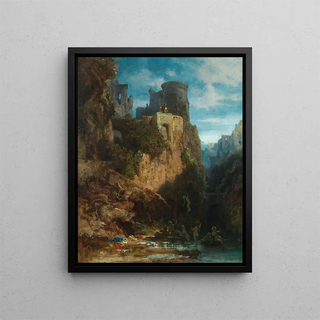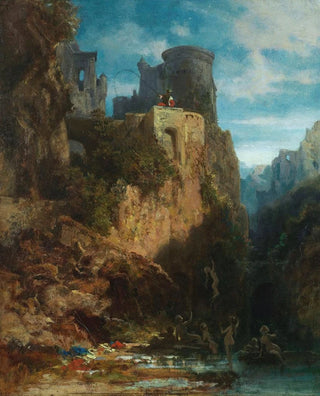Art print | Mermaid Catcher - Carl Spitzweg


View from behind

Frame (optional)
At the heart of the enchanting universe of German Romantic art, "Attrape-sirène" by Carl Spitzweg stands out for its ability to evoke deep emotions and reflections on human nature. This piece, imbued with poetry and mystery, invites the viewer to immerse themselves in a world where dream and reality intertwine. Spitzweg, a master of depicting everyday life and intimate scenes, succeeds here in capturing the essence of a maritime legend while revealing human aspirations and desires. The art print of this iconic work allows for rediscovering the magic of art through a contemporary perspective, all while preserving the narrative richness that characterizes the original.
Style and uniqueness of the work
The work "Attrape-sirène" is distinguished by its delicate and refined style, typical of Romantic aesthetics. Spitzweg uses warm colors and meticulous details to create an atmosphere that is both serene and captivating. The composition, centered on a character intrigued by the idea of catching a sirène, is both playful and symbolic. The sirène, a mythical figure embodying both beauty and danger, is depicted with enchanting grace, while the protagonist, with a dreamy expression, appears caught in a moment of contemplation. This contrast between human innocence and the mystique of the marine creature creates a narrative tension that invites interpretation. Natural elements, such as the sea and rocks, are carefully integrated, strengthening the connection between man and his environment. This work, through its apparent simplicity, reveals layers of meaning that resonate with the human soul.
The artist and his influence
Carl Spitzweg, born in 1808 in Munich, is an emblematic figure of the Romantic movement. His career, marked by numerous works, testifies to a deep commitment to depicting everyday life and human aspirations. Spitzweg was able to capture the spirit of his time, blending humor and melancholy in his creations. His influence extends beyond the borders of Germany, inspiring many artists across Europe. In exploring

Matte finish

View from behind

Frame (optional)
At the heart of the enchanting universe of German Romantic art, "Attrape-sirène" by Carl Spitzweg stands out for its ability to evoke deep emotions and reflections on human nature. This piece, imbued with poetry and mystery, invites the viewer to immerse themselves in a world where dream and reality intertwine. Spitzweg, a master of depicting everyday life and intimate scenes, succeeds here in capturing the essence of a maritime legend while revealing human aspirations and desires. The art print of this iconic work allows for rediscovering the magic of art through a contemporary perspective, all while preserving the narrative richness that characterizes the original.
Style and uniqueness of the work
The work "Attrape-sirène" is distinguished by its delicate and refined style, typical of Romantic aesthetics. Spitzweg uses warm colors and meticulous details to create an atmosphere that is both serene and captivating. The composition, centered on a character intrigued by the idea of catching a sirène, is both playful and symbolic. The sirène, a mythical figure embodying both beauty and danger, is depicted with enchanting grace, while the protagonist, with a dreamy expression, appears caught in a moment of contemplation. This contrast between human innocence and the mystique of the marine creature creates a narrative tension that invites interpretation. Natural elements, such as the sea and rocks, are carefully integrated, strengthening the connection between man and his environment. This work, through its apparent simplicity, reveals layers of meaning that resonate with the human soul.
The artist and his influence
Carl Spitzweg, born in 1808 in Munich, is an emblematic figure of the Romantic movement. His career, marked by numerous works, testifies to a deep commitment to depicting everyday life and human aspirations. Spitzweg was able to capture the spirit of his time, blending humor and melancholy in his creations. His influence extends beyond the borders of Germany, inspiring many artists across Europe. In exploring






